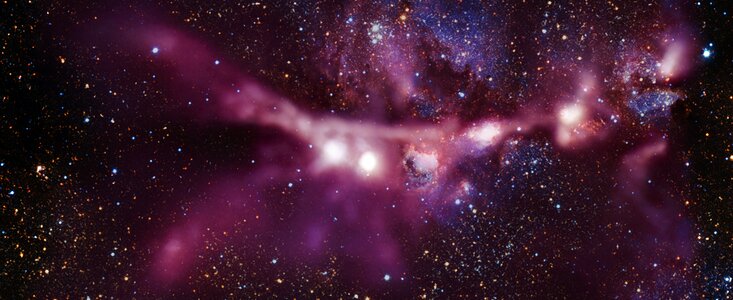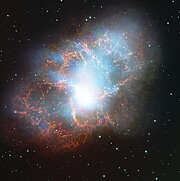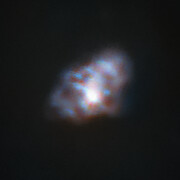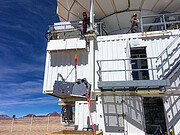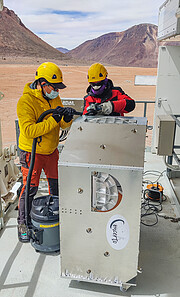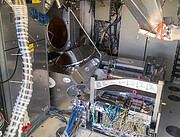Tiedote
Show alkakoon! APEXin CONCERTO-instrumentti on tehnyt ensimmäiset havaintonsa
6. heinäkuuta 2021
Spektrometri nimeltään CONCERTO on hieno uusi instrumentti, ja se on onnistunut tekemään ensimmäiset havaintonsa. Se on ottanut testikuvat Kissantassunumusta ja Rapusumusta. ESO:n operoimaan Atacama Pathfinder Experiment (APEX) -havaintolaitteeseen asennettu laite auttaa tähtitieteilijöitä tutkimaan salaperäistä, muinaista kosmista aikakautta, jonka aikana ensimmäiset tähdet syttyivät.
CONCERTO on lyhenne sanoista 'CarbON CII line in post-rEionisation and ReionisaTiOn epoch', ja se päätavoitteena on tutkia ensimmäisen sukupolven tähtiä. Tätä varten se havaitsee avaruuden kohteita, jotka muodostuivat 600-1,2 miljardin vuoden kuluessa alkuräjähdyksen jälkeen. Tämä aikakausi, joka tunnetaan kosmisena uudelleenionisaation aikakautena, on huonosti ymmärretty, mutta hyvin merkittävä kosmologian historiassa. Aikakausi merkitsee siirtymäaikaa ”pimeän ajan” (hyvin hämärä aika maailmankaikkeudessa, jolloin tähtiä ei vielä ollut muodostunut) ja näkemiemme kaukausimpien galaksien ajan välillä. CONCERTO kartoittaa myös kaukaisia galaksijoukkoja ja Linnunradassamme olevia tähtiä muodostavia alueita.
CONCERTO havaitsee taivasta infrapuna- ja radioaaltojen välisillä taajuuksilla ja se havaitsee ionisoituneiden hiiliatomien lähettämää säteilyä. Se on yksi varhaisten kosmisten aikojen arvokkaimmista tähtien muodostumisen merkeistä. ”Uudelleenionisaation ajan tutkiminen on erittäin haastavaa, sillä etsimämme signaali on hyvin heikko”, CONCERTOn päätutkija Guilaine Lagache Ranskan Laboratoire d'Astrophysique de Marseillesta sanoi. ”Aiomme tutkia aihetta käyttämällä täysin innovatiivista ja kokeellista havaintotekniikkaa, jota kutsutaan intensiteettikartoitukseksi. CONCERTosta tulee ensimmäinen instrumentti maailmassa, jonka avulla alkukantaisen (primordial) hiilen säteily kartoitetaan suurelta taivaan alueelta”.
”APEXin CONCERTO on täysin ainutlaatuinen”, ESO-tähtitieteilijä ja APEX-projektitutkija Carlos De Breuck sanoi. ”Muut instrumentit keskittyvät joko kuvantamiseen tai spektroskopiaan, mutta eivät molempiin, kuten CONCERTO tekee. Kuvantamisen näkökentän läpimitta taivaalla on noin 20 kaariminuuttia ja, se on ehdottomasti suurin APEXin koskaan käytetty näkökenttä.” Uusi instrumentti on korvannut LArge APEX BOlometer CAmera (LABOCA) -instrumentin. Uusi instrumentti mahdollistaa nelinkertaisen parannuksen näkökenttään.
CONCERTOn ensimmäiset havainnot merkitsevät asennusprosessin päättymistä. Vaihe alkoi instrumentin toimittamisesta APEXin sijoituspaikalle Chanjantorin tasangolle Chilen Atacaman autiomaahan maaliskuun lopulla 2021.
COVID-19 -pandemia asetti CONCERTO-ryhmälle huomattavan haasteen. Ryhmä pystyi muuttamaan instrumentin täysin etänä ohjattavaksi, lähettämään sen Chileen ja asentamaan sen APEXiin tiukoissa terveys- ja turvallisuusolosuhteissa. ”Suuri tekijä menestyksen takana on ryhmän joukkuehenki ja se, että me kaikki työskentelemme suurella intohimolla ja päättäväisyydellä”, CONCERTO-instrumentin tutkija Alessandro Monfardini Institut Néelistä Ranskan Grenoblesta sanoi. Ryhmä on myös kiitollinen paikalliselle APEX-henkilöstölle heidän omistautumisestaan ja avustaan laitteen asentamisessa ja testaamisessa.
Lisätietoja
CONCERTO on saanut rahoitusta Euroopan tutkimusneuvostolta avustussopimuksella nro 788212, Aix-Marseille Initiative of Excellence (Ranska) ja LabEX FOCUS (Ranska) -aloitteesta. CONCERTO-konsortioon kuuluvat laitokset ovat Laboratoire d'Astrophysique de Marseille (LAM; Ranska), Institut Néel (Ranska), Laboratoire de Physique Subatomique et de Cosmologie (LPSC; Ranska), Institut de Planétologie et d'Astrophysique (IPAG, Ranska) ja tähtitieteen instrumentaatio Ryhmä Cardiffin yliopistosta (Yhdistynyt kuningaskunta). Institut Néel, LPSC ja IPAG ovat Centre National de la Recherche Scientifiquen (CNRS) ja Université Grenoble Alpesin (UGA) laboratorioita. LAM on CNRS:n ja Aix-Marseillen yliopiston laboratorio.
APEX toimii Max Planckin radiotähtitieteen instituutin (MPIfR), Onsalan avaruusobservatorion (OSO) ja ESO:n yhteistyönä. APEX:in operointi Chajnantorissa on saatettu ESO:n tehtäväksi.
Linkit
Yhteystiedot
Guilaine Lagache
CONCERTO’s Principal Investigator
Laboratoire d'Astrophysique de Marseille
Marseille, Ranska
Puh.: +33 6 50 77 35 45
S-posti: guilaine.lagache@lam.fr
Alessandro Monfardini
CONCERTO’s Instrument Scientist
Institut Néel
Grenoble, Ranska
Puh.: +33 4 76 88 10 52
S-posti: alessandro.monfardini@neel.cnrs.fr
Carlos De Breuck
ESO APEX Project Scientist
Garching bei München, Saksa
Puh.: +49 89 3200 6613 S-posti: cdebreuc@eso.org
Bárbara Ferreira
ESO Media Manager
Garching bei München, Saksa
Puh.: +49 89 3200 6670
S-posti: press@eso.org
Tiedotteesta
| Tunnistus: | ann21010 |
Our use of Cookies
We use cookies that are essential for accessing our websites and using our services. We also use cookies to analyse, measure and improve our websites’ performance, to enable content sharing via social media and to display media content hosted on third-party platforms.
ESO Cookies Policy
The European Organisation for Astronomical Research in the Southern Hemisphere (ESO) is the pre-eminent intergovernmental science and technology organisation in astronomy. It carries out an ambitious programme focused on the design, construction and operation of powerful ground-based observing facilities for astronomy.
This Cookies Policy is intended to provide clarity by outlining the cookies used on the ESO public websites, their functions, the options you have for controlling them, and the ways you can contact us for additional details.
What are cookies?
Cookies are small pieces of data stored on your device by websites you visit. They serve various purposes, such as remembering login credentials and preferences and enhance your browsing experience.
Categories of cookies we use
Essential cookies (always active): These cookies are strictly necessary for the proper functioning of our website. Without these cookies, the website cannot operate correctly, and certain services, such as logging in or accessing secure areas, may not be available; because they are essential for the website’s operation, they cannot be disabled.
Functional Cookies: These cookies enhance your browsing experience by enabling additional features and personalization, such as remembering your preferences and settings. While not strictly necessary for the website to function, they improve usability and convenience; these cookies are only placed if you provide your consent.
Analytics cookies: These cookies collect information about how visitors interact with our website, such as which pages are visited most often and how users navigate the site. This data helps us improve website performance, optimize content, and enhance the user experience; these cookies are only placed if you provide your consent. We use the following analytics cookies.
Matomo Cookies:
This website uses Matomo (formerly Piwik), an open source software which enables the statistical analysis of website visits. Matomo uses cookies (text files) which are saved on your computer and which allow us to analyze how you use our website. The website user information generated by the cookies will only be saved on the servers of our IT Department. We use this information to analyze www.eso.org visits and to prepare reports on website activities. These data will not be disclosed to third parties.
On behalf of ESO, Matomo will use this information for the purpose of evaluating your use of the website, compiling reports on website activity and providing other services relating to website activity and internet usage.
Matomo cookies settings:
Additional Third-party cookies on ESO websites: some of our pages display content from external providers, e.g. YouTube.
Such third-party services are outside of ESO control and may, at any time, change their terms of service, use of cookies, etc.
YouTube: Some videos on the ESO website are embedded from ESO’s official YouTube channel. We have enabled YouTube’s privacy-enhanced mode, meaning that no cookies are set unless the user actively clicks on the video to play it. Additionally, in this mode, YouTube does not store any personally identifiable cookie data for embedded video playbacks. For more details, please refer to YouTube’s embedding videos information page.
Cookies can also be classified based on the following elements.
Regarding the domain, there are:
- First-party cookies, set by the website you are currently visiting. They are stored by the same domain that you are browsing and are used to enhance your experience on that site;
- Third-party cookies, set by a domain other than the one you are currently visiting.
As for their duration, cookies can be:
- Browser-session cookies, which are deleted when the user closes the browser;
- Stored cookies, which stay on the user's device for a predetermined period of time.
How to manage cookies
Cookie settings: You can modify your cookie choices for the ESO webpages at any time by clicking on the link Cookie settings at the bottom of any page.
In your browser: If you wish to delete cookies or instruct your browser to delete or block cookies by default, please visit the help pages of your browser:
Please be aware that if you delete or decline cookies, certain functionalities of our website may be not be available and your browsing experience may be affected.
You can set most browsers to prevent any cookies being placed on your device, but you may then have to manually adjust some preferences every time you visit a site/page. And some services and functionalities may not work properly at all (e.g. profile logging-in, shop check out).
Updates to the ESO Cookies Policy
The ESO Cookies Policy may be subject to future updates, which will be made available on this page.
Additional information
For any queries related to cookies, please contact: pdprATesoDOTorg.
As ESO public webpages are managed by our Department of Communication, your questions will be dealt with the support of the said Department.
